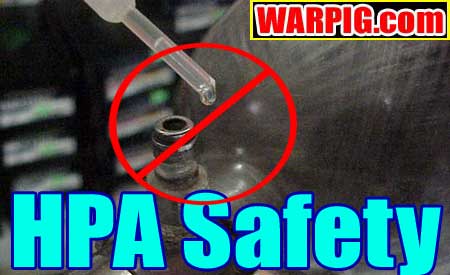  |
|
|
|
|
|
|
  |
|
|
|
|
|
|

|

Don't Blow Yourself Up August 2002 Oil and compressed air do not, and should not be mixed. Many people have taken to the practice of dropping paintgun oil into the fill nipple of their compressed air system, especially in the hopes of sealing a leaky fill nipple. While this would not be a real problem using the inert gas nitrogen, most "nitrogen" systems in paintball are actually filled with compressed air. As air is compressed the amount of oxygen (as well as the other gasses in the air) is increased. Fire, also known as combustion, or an exothermic oxidation reaction requires three things to start: oxygen, fuel and heat. The temperature needed to start a particular fuel burning is known as that fuel's flash point. As the amount of oxygen a fuel is exposed to increases, the flash point drops. With some materials like phosphorus, the flash point is below room temperature, and they will catch fire when exposed to air. There are many oils which are perfectly safe at room temperature and air pressure. However, when the oxygen content around them increases - as with air compressed into a paintgun's HPA tank, the flash point can lower to below the temperature of the fill air and cause the oil to ignite. This is the principle at work in the cylinders of a diesel engine. In a recent telephone interview with WARPIG.com, Shawn Townsend of Compressed Air Specialties, Inc., a Bauer Compressor distributor in Southern California, related a warning against using oils in HPA tanks and the story of an accident that occurred at SC Village. According to Townsend, a customer at the field experienced a leak in the fill nipple of his air system and treated it with a few drops of paintgun oil dropped into the nipple before taking his gear to the air fill station. The player started to fill his tank and dropped it, shouting. Townsend says he stepped over to investigate and smelled the after effects of a fire, and found the fill hose and fill nipple coated in a black film. Townsend theorized that the fill nipple would have sprayed the oil into a mist, much like the fuel injector in an automobile engine, further increasing the surface area in contact with oxygen and lowering the flash point. Townsend said that the resulting fire flashed through the tank and the hose. Fortunately the explosion was small, and did not create any shrapnel, so no one was injured. Townsend ended up taking the fill hose out of service, and recommended that the customer have the tank both visually inspected and hydrostatically tested by a DOT certified inspector before filling it again. Paintball safety lies in the hands of the
players. Do not put oil, or any other lubricants into your compressed
air system's tank or fill nipple. No lubricants should be used on
the regulator unless they are explicitly recommended by the manufacturer.
|
| Copyright © 1992-2019
Corinthian Media Services. WARPIG's webmasters can be reached through our feedback form. All articles and images are copyrighted and may not be redistributed without the written permission of their original creators and Corinthian Media Services. The WARPIG paintball page is a collection of information and pointers to sources from around the internet and other locations. As such, Corinthian Media Services makes no claims to the trustworthiness or reliability of said information. The information contained in, and referenced by WARPIG, should not be used as a substitute for safety information from trained professionals in the paintball industry. |